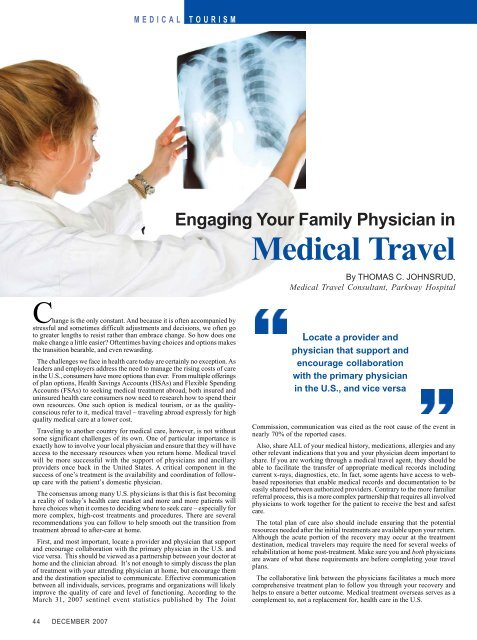Download PDF - Medical Tourism Magazine
Download PDF - Medical Tourism Magazine
Download PDF - Medical Tourism Magazine
Create successful ePaper yourself
Turn your PDF publications into a flip-book with our unique Google optimized e-Paper software.
MEDICAL TOURISM<br />
Change is the only constant. And because it is often accompanied by<br />
stressful and sometimes difficult adjustments and decisions, we often go<br />
to greater lengths to resist rather than embrace change. So how does one<br />
make change a little easier? Oftentimes having choices and options makes<br />
the transition bearable, and even rewarding.<br />
The challenges we face in health care today are certainly no exception. As<br />
leaders and employers address the need to manage the rising costs of care<br />
in the U.S., consumers have more options than ever. From multiple offerings<br />
of plan options, Health Savings Accounts (HSAs) and Flexible Spending<br />
Accounts (FSAs) to seeking medical treatment abroad, both insured and<br />
uninsured health care consumers now need to research how to spend their<br />
own resources. One such option is medical tourism, or as the qualityconscious<br />
refer to it, medical travel – traveling abroad expressly for high<br />
quality medical care at a lower cost.<br />
Traveling to another country for medical care, however, is not without<br />
some significant challenges of its own. One of particular importance is<br />
exactly how to involve your local physician and ensure that they will have<br />
access to the necessary resources when you return home. <strong>Medical</strong> travel<br />
will be more successful with the support of physicians and ancillary<br />
providers once back in the United States. A critical component in the<br />
success of one’s treatment is the availability and coordination of followup<br />
care with the patient’s domestic physician.<br />
The consensus among many U.S. physicians is that this is fast becoming<br />
a reality of today’s health care market and more and more patients will<br />
have choices when it comes to deciding where to seek care – especially for<br />
more complex, high-cost treatments and procedures. There are several<br />
recommendations you can follow to help smooth out the transition from<br />
treatment abroad to after-care at home.<br />
First, and most important, locate a provider and physician that support<br />
and encourage collaboration with the primary physician in the U.S. and<br />
vice versa. This should be viewed as a partnership between your doctor at<br />
home and the clinician abroad. It’s not enough to simply discuss the plan<br />
of treatment with your attending physician at home, but encourage them<br />
and the destination specialist to communicate. Effective communication<br />
between all individuals, services, programs and organizations will likely<br />
improve the quality of care and level of functioning. According to the<br />
March 31, 2007 sentinel event statistics published by The Joint<br />
44 DECEMBER 2007<br />
Engaging Your Family Physician in<br />
<strong>Medical</strong> Travel<br />
By THOMAS C. JOHNSRUD,<br />
<strong>Medical</strong> Travel Consultant, Parkway Hospital<br />
Locate a provider and<br />
physician that support and<br />
encourage collaboration<br />
with the primary physician<br />
in the U.S., and vice versa<br />
Commission, communication was cited as the root cause of the event in<br />
nearly 70% of the reported cases.<br />
Also, share ALL of your medical history, medications, allergies and any<br />
other relevant indications that you and your physician deem important to<br />
share. If you are working through a medical travel agent, they should be<br />
able to facilitate the transfer of appropriate medical records including<br />
current x-rays, diagnostics, etc. In fact, some agents have access to webbased<br />
repositories that enable medical records and documentation to be<br />
easily shared between authorized providers. Contrary to the more familiar<br />
referral process, this is a more complex partnership that requires all involved<br />
physicians to work together for the patient to receive the best and safest<br />
care.<br />
The total plan of care also should include ensuring that the potential<br />
resources needed after the initial treatments are available upon your return.<br />
Although the acute portion of the recovery may occur at the treatment<br />
destination, medical travelers may require the need for several weeks of<br />
rehabilitation at home post-treatment. Make sure you and both physicians<br />
are aware of what these requirements are before completing your travel<br />
plans.<br />
The collaborative link between the physicians facilitates a much more<br />
comprehensive treatment plan to follow you through your recovery and<br />
helps to ensure a better outcome. <strong>Medical</strong> treatment overseas serves as a<br />
complement to, not a replacement for, health care in the U.S.


